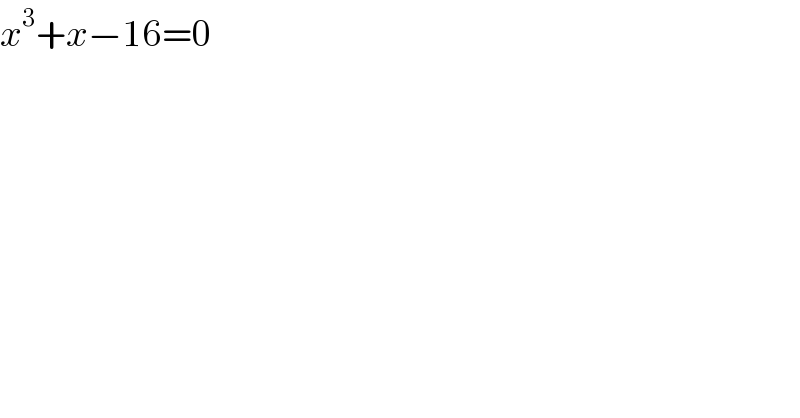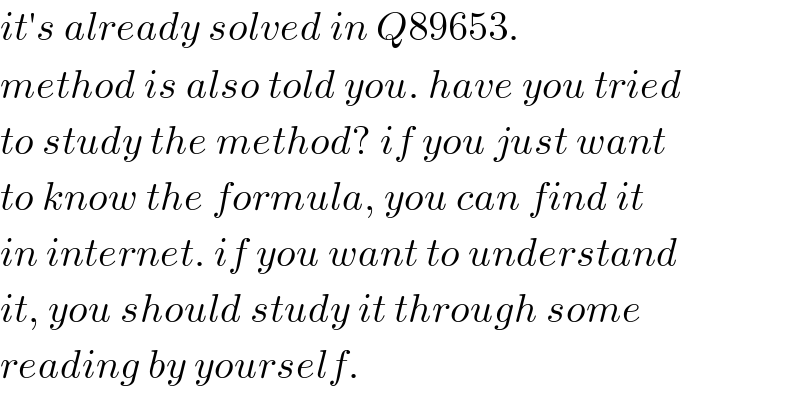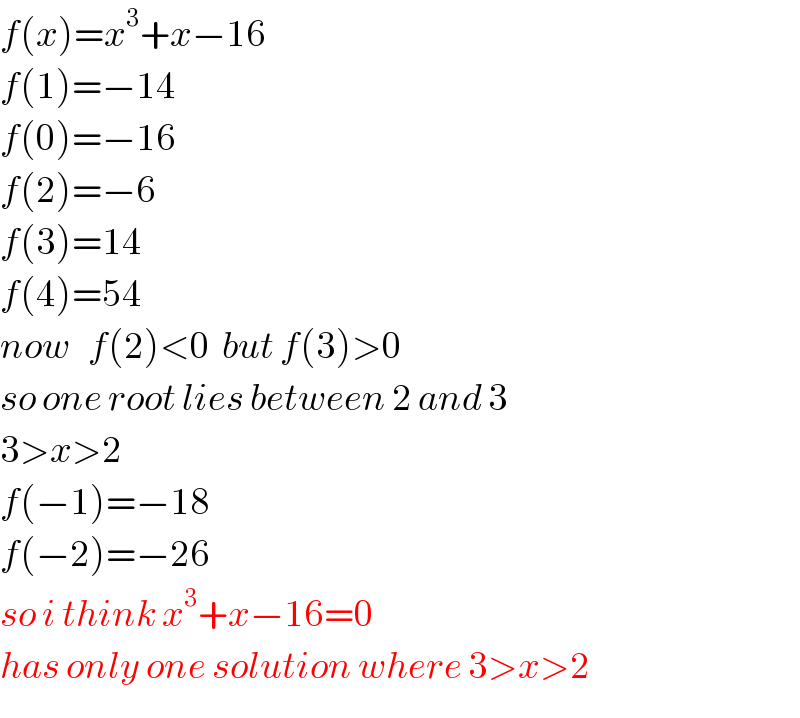Question Number 89687 by student work last updated on 18/Apr/20

$${x}^{\mathrm{3}} +{x}−\mathrm{16}=\mathrm{0} \\ $$
Commented by mr W last updated on 18/Apr/20
https://en.m.wikipedia.org/wiki/Cubic_equation
Commented by mr W last updated on 18/Apr/20

$${it}'{s}\:{already}\:{solved}\:{in}\:{Q}\mathrm{89653}. \\ $$$${method}\:{is}\:{also}\:{told}\:{you}.\:{have}\:{you}\:{tried} \\ $$$${to}\:{study}\:{the}\:{method}?\:{if}\:{you}\:{just}\:{want} \\ $$$${to}\:{know}\:{the}\:{formula},\:{you}\:{can}\:{find}\:{it} \\ $$$${in}\:{internet}.\:{if}\:{you}\:{want}\:{to}\:{understand} \\ $$$${it},\:{you}\:{should}\:{study}\:{it}\:{through}\:{some} \\ $$$${reading}\:{by}\:{yourself}. \\ $$
Commented by MJS last updated on 18/Apr/20

$$\mathrm{Cardano}'\mathrm{s}\:\mathrm{Method} \\ $$$$\:\:\:\:\:{ax}^{\mathrm{3}} +{bx}^{\mathrm{2}} +{cx}+{d}=\mathrm{0} \\ $$$$\left(\mathrm{1}\right)\:\mathrm{divide}\:\mathrm{by}\:{a}\:\Rightarrow \\ $$$$\:\:\:\:\:{x}^{\mathrm{3}} +\frac{{b}}{{a}}{x}^{\mathrm{2}} +\frac{{c}}{{a}}{x}+\frac{{d}}{{a}}=\mathrm{0} \\ $$$$\left(\mathrm{2}\right)\:\mathrm{let}\:{z}={x}−\frac{{b}}{\mathrm{3}{a}}\:\Rightarrow \\ $$$$\:\:\:\:\:{z}^{\mathrm{3}} +\frac{\mathrm{3}{ac}−{b}^{\mathrm{2}} }{\mathrm{3}{a}^{\mathrm{2}} }{z}+\frac{\mathrm{27}{a}^{\mathrm{2}} {d}−\mathrm{9}{abc}+\mathrm{2}{b}^{\mathrm{3}} }{\mathrm{27}{a}^{\mathrm{3}} }=\mathrm{0} \\ $$$$\left(\mathrm{3}\right)\:\mathrm{let}\:\frac{\mathrm{3}{ac}−{b}^{\mathrm{2}} }{\mathrm{3}{a}^{\mathrm{2}} }={p}\:\mathrm{and}\:\frac{\mathrm{27}{a}^{\mathrm{2}} {d}−\mathrm{9}{abc}+\mathrm{2}{b}^{\mathrm{3}} }{\mathrm{27}{a}^{\mathrm{3}} }={q}\:\Rightarrow \\ $$$$\:\:\:\:\:{z}^{\mathrm{3}} +{pz}+{q}=\mathrm{0}\:\Leftrightarrow\:{z}^{\mathrm{3}} =−{pz}−{q} \\ $$$$\left(\mathrm{4}\right)\:\mathrm{Cardano}'\mathrm{s}\:\mathrm{new}\:\mathrm{idea}:\:\mathrm{let}\:{z}={u}+{v}\:\mathrm{on}\:\mathrm{lhs} \\ $$$$\:\:\:\:\:\left({u}+{v}\right)^{\mathrm{3}} =−{pz}−{q} \\ $$$$\:\:\:\:\:{u}^{\mathrm{3}} +\mathrm{3}{u}^{\mathrm{2}} {v}+\mathrm{3}{uv}^{\mathrm{2}} +{v}^{\mathrm{3}} =−{pz}−{q} \\ $$$$\:\:\:\:\:\mathrm{3}{uv}\left({u}+{v}\right)+{u}^{\mathrm{3}} +{v}^{\mathrm{3}} =−{pz}−{q} \\ $$$$\:\:\:\:\:\mathrm{3}{uvz}+{u}^{\mathrm{3}} +{v}^{\mathrm{3}} =−{pz}−{q} \\ $$$$\:\:\:\:\:\mathrm{by}\:\mathrm{matching}\:\mathrm{constants}\:\mathrm{we}\:\mathrm{get} \\ $$$$\:\:\:\:\:\begin{cases}{\mathrm{I}.\:\:{uv}=−\frac{{p}}{\mathrm{3}}\:\Leftrightarrow\:{u}^{\mathrm{3}} {v}^{\mathrm{3}} =−\frac{{p}^{\mathrm{3}} }{\mathrm{27}}}\\{\mathrm{II}.\:{u}^{\mathrm{3}} +{v}^{\mathrm{3}} =−{q}}\end{cases} \\ $$$$\left(\mathrm{5}\right)\:\mathrm{let}\:{u}^{\mathrm{3}} ={s}\:\mathrm{and}\:{v}^{\mathrm{3}} ={t}\:\Rightarrow \\ $$$$\:\:\:\:\:\begin{cases}{\mathrm{I}.\:\:{st}=−\frac{{p}^{\mathrm{3}} }{\mathrm{27}}}\\{\mathrm{II}.\:{s}+{t}=−{q}}\end{cases} \\ $$$$\:\:\:\:\:\mathrm{this}\:\mathrm{leads}\:\mathrm{to}\:\mathrm{a}\:\mathrm{quadratic}: \\ $$$$\:\:\:\:\:\mathrm{I}.\:\Rightarrow\:{s}=−\frac{{p}^{\mathrm{3}} }{\mathrm{27}{t}};\:\mathrm{insert}\:\mathrm{in}\:\mathrm{II}.\:\Rightarrow \\ $$$$\:\:\:\:\:{t}−\frac{{p}^{\mathrm{3}} }{\mathrm{27}{t}}=−{q}\:\Leftrightarrow\:{t}^{\mathrm{2}} +{qt}−\frac{{p}^{\mathrm{3}} }{\mathrm{27}}=\mathrm{0}\:\Rightarrow \\ $$$$\:\:\:\:\:\Rightarrow\:{t}=−\frac{{q}}{\mathrm{2}}\pm\sqrt{\frac{{q}^{\mathrm{2}} }{\mathrm{4}}+\frac{{p}^{\mathrm{3}} }{\mathrm{27}}} \\ $$$$\:\:\:\:\:\Rightarrow\:{s}=−\frac{{q}}{\mathrm{2}}\mp\sqrt{\frac{{q}^{\mathrm{2}} }{\mathrm{4}}+\frac{{p}^{\mathrm{3}} }{\mathrm{27}}} \\ $$$$\:\:\:\:\:\Rightarrow\:\mathrm{we}\:\mathrm{are}\:\mathrm{free}\:\mathrm{to}\:\mathrm{choose}\:\mathrm{the}\:“+''\:\mathrm{value} \\ $$$$\:\:\:\:\:\mathrm{for}\:{t}\:\mathrm{and}\:\mathrm{the}\:“−''\:\mathrm{value}\:\mathrm{for}\:{s} \\ $$$$\:\:\:\:\:\Rightarrow\:{u}=\sqrt[{\mathrm{3}}]{−\frac{{q}}{\mathrm{2}}−\sqrt{\frac{{q}^{\mathrm{2}} }{\mathrm{4}}+\frac{{p}^{\mathrm{3}} }{\mathrm{27}}}}\:\mathrm{and}\:{v}=\sqrt[{\mathrm{3}}]{−\frac{{q}}{\mathrm{2}}+\sqrt{\frac{{q}^{\mathrm{2}} }{\mathrm{4}}+\frac{{p}^{\mathrm{3}} }{\mathrm{27}}}} \\ $$$$\:\:\:\:\:\Rightarrow\:{z}_{\mathrm{1}} ={u}+{v} \\ $$$$\:\:\:\:\:\:\:\:\:\:{z}^{\mathrm{3}} +{pz}+{q}=\left({z}−{z}_{\mathrm{1}} \right)\left({z}^{\mathrm{2}} +\left({u}+{v}\right){z}+{u}^{\mathrm{2}} −{uv}+{v}^{\mathrm{2}} \right) \\ $$$$\:\:\:\:\:\mathrm{and}\:\mathrm{we}\:\mathrm{can}\:\mathrm{solve}\:\mathrm{this} \\ $$$$ \\ $$$$\mathrm{the}\:\mathrm{only}\:\mathrm{limitation}\:\mathrm{is} \\ $$$${D}=\frac{{q}^{\mathrm{2}} }{\mathrm{4}}+\frac{{p}^{\mathrm{3}} }{\mathrm{27}}\geqslant\mathrm{0} \\ $$$$\mathrm{if}\:{D}<\mathrm{0}\:\mathrm{we}\:\mathrm{need}\:\mathrm{the}\:\mathrm{trigonometric}\:\mathrm{solution} \\ $$
Answered by TANMAY PANACEA. last updated on 18/Apr/20

$${f}\left({x}\right)={x}^{\mathrm{3}} +{x}−\mathrm{16} \\ $$$${f}\left(\mathrm{1}\right)=−\mathrm{14} \\ $$$${f}\left(\mathrm{0}\right)=−\mathrm{16} \\ $$$${f}\left(\mathrm{2}\right)=−\mathrm{6} \\ $$$${f}\left(\mathrm{3}\right)=\mathrm{14} \\ $$$${f}\left(\mathrm{4}\right)=\mathrm{54} \\ $$$${now}\:\:\:{f}\left(\mathrm{2}\right)<\mathrm{0}\:\:{but}\:{f}\left(\mathrm{3}\right)>\mathrm{0} \\ $$$${so}\:{one}\:{root}\:{lies}\:{between}\:\mathrm{2}\:{and}\:\mathrm{3} \\ $$$$\mathrm{3}>{x}>\mathrm{2} \\ $$$${f}\left(−\mathrm{1}\right)=−\mathrm{18} \\ $$$${f}\left(−\mathrm{2}\right)=−\mathrm{26} \\ $$$${so}\:{i}\:{think}\:{x}^{\mathrm{3}} +{x}−\mathrm{16}=\mathrm{0} \\ $$$${has}\:{only}\:{one}\:{solution}\:{where}\:\mathrm{3}>{x}>\mathrm{2} \\ $$
